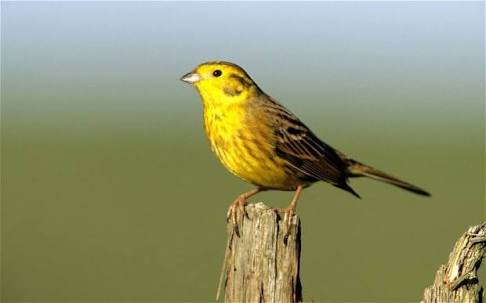Yellow Hammer (species of birds)
The yellowhammer (Emberiza citrinella) is a passerine bird in the bunting family that is native to Eurasia and introduced to New Zealand, Australia, the Falkland Islands, Peru, and South Africa. Most European birds remain in the breeding range year-round, but the eastern subspecies is partially migratory, with much of the population wintering further south. The male yellowhammer has a bright yellow head, streaked brown back, chestnut rump and yellow underparts. Other plumages are duller versions of the same pattern. The yellowhammer is common in open areas with some shrubs or trees, and forms small flocks in winter. It has a characteristic song with an "A little bit of bread and no cheese" rhythm. The song is very similar to that of its closest relative, the pine bunting, with which it interbreeds.
Breeding commences mainly in April and May, with the female building a lined cup nest in a concealed location on or near the ground. The 3–5 eggs are patterned with a mesh of fine dark lines, giving rise to the old name for the bird of "scribble lark". The female incubates the eggs for 12–14 days to hatching, and broods the altricial downy chicks until they fledge 11–13 days later. Both adults feed the chick in the nest and raise two or three broods each year. The nest may be raided by rodents or corvids, and the adults are hunted by birds of prey. Yellowhammers feed on the ground, usually in flocks outside the breeding season. The diet is mainly seeds, supplemented by invertebrates in the breeding season. Changes to agricultural practices have led to population declines in western Europe, but its large numbers and huge range mean that the yellowhammer is classed as being of least concern by the International Union for Conservation of Nature (IUCN).
This conspicuous yellow bird has inspired poems by Rabbie Burns and John Clare, and its characteristic song has influenced works by Beethoven and Messiaen. The children's writer Enid Blyton helped to popularise the standard English representation of the song.
Taxonomy:
The bird family Emberizidae contains around 300 seed-eating species, the majority of which are found in the Americas, although the genus Emberiza, with more than forty members, is confined to the Old World. Within its genus, the yellowhammer is most closely related to the pine bunting, with which it forms a superspecies; they have at times been considered as one species. The white-capped and cirl buntings are also near relatives of the species pair. Where their ranges meet, the yellowhammer and pine bunting interbreed; the yellowhammer is dominant, and the hybrid zone is moving further east.
The yellowhammer was described by Linnaeus in his Systema Naturae in 1758 under its current scientific name. Emberiza is derived from the Old German embritz, a bunting, and citrinella is the Italian for a small yellow bird. The English name is thought to have come from ammer, another German word for a bunting, and was first recorded in 1553 as yelambre.
Subspecies
There are three recognised subspecies. E. c. citrinella (Linnaeus, 1758), the nominate subspecies, occurs in southeast England and most of Europe east to the northwestern corner of Russia and western Ukraine, E. c. caliginosa (Clancey, 1940) is the form found in Ireland, the Isle of Man and Great Britain (except southeast England), and E. c. erythrogenys (Brehm, 1855) breeds from Russia, central Ukraine and the eastern Balkans eastwards to Siberia and northwest Mongolia, and also has isolated populations to the east of the Black Sea and in the Caucasus..jpg)
.jpg)